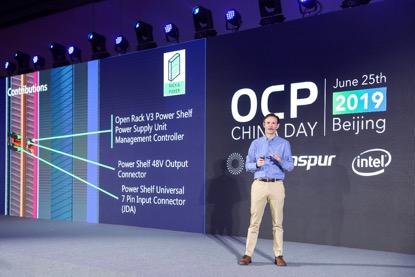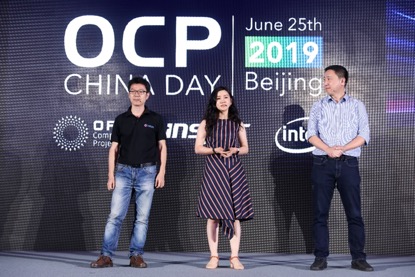On June 25th, the OCP China Day, sponsored by Inspur, an OCP Platinum member, was held in Beijing. Nearly 800 engineers and data center practitioners attended the conference. Senior technical experts from Facebook, LinkedIn, Intel, Microsoft, Baidu, Tencent, Alibaba, Nokia, China Mobile and Inspur gave keynote speeches and shared collaboration efforts in frontier areas such as next-generation whole rack servers, edge computing, AI and open networks. Nearly 200,000 additional people attended the event remotely via live-stream.
At the conference, Steve Mills, one of the leaders of the OCP Rack & Power Project Group, introduced the latest Open Rack 3.0 whole rack architectural specification. Compared with the previous version, liquid cooling has been added, and the power to the whole rack power has been increased to 15–33KW. With the addition of 48V DC power supply, the energy efficiency has also improved. The height has been increased from 41 OU to 44 OU, resulting in improved space utilization. The internal structure has been adjusted with space reserved for the expansion of individual functions such as I/O and storage. At present, the specification has not been officially released but is being discussed within the OCP Rack & Power Project Group.

The rapid development of AI has driven the development of a range of heterogeneous acceleration solutions for applications such as deep learning, machine learning and high-performance computing. Due to various technical challenges and the complexity of the accelerator hardware system, it usually takes about 6 to 12 months to integrate the accelerator into the system. This long development cycle hinders the rapid adoption of new AI accelerators. The OCP Community established an Open Accelerator Infrastructure (OAI) group under the Server Project Group to develop the OCP Accelerator Module (OAM) specification, standardize the accelerator module, simplify the design of the AI infrastructure, and shorten the hardware design cycle.

The OCP community has established an Open Edge Subgroup in the Telco Project Group, with the hope of developing a set of open platform for hardware facilities such as edge computing servers. Nokia, a leader of the subgroup, has contributed the Open Edge Chassis Specification v1.2 standard. Tomi Männikkö, head of Nokia's Hardware Architecture Department, said in his speech at the conference that the basic deployment unit defined in this standard is a 3U chassis with a width of 19 inches and a depth of 430mm, which supports 1U and 2U expansion nodes with half width, 1/4 width and full width. With a maximum supply power of 2000W, the chassis supports both AC and DC power supply modes and is compatible with various deployment environments such as edge computing and remote edge computing.
Inspur also showcased two edge computing servers. These two products are 2U two-way servers with a depth of 430mm. With a wide temperature and humidity range and high corrosion resistance, they support GPU and NVM-e and have undergone NUMA balancing optimization for telco applications.
OpenRMC, a uniform and open management architecture for data centers
OCP is building the next-generation data center management architecture, and the mission of the community's Open Firmware Project team is to develop agile, open and standard firmware design specifications to meet the development needs of the next-generation cloud computing infrastructure. The project team is developing open-source kits that include only the most basic platform code to identify white-box hardware, while using Intel® FSP to develop a white-box hardware system that is deployable and bootable to shape an Open Firmware ecosystem integrating both software and hardware.
OpenRMC, another Project Team in the community, is working on the integration of OpenBMC and Redfish to constitute a uniform framework for management of next-generation data centers. Led by Inspur, the OpenBMC project belongs to the Linux community with an aim to address the standard inconsistency between closed-source BMC and related software packages. Redfish is the next-generation data center management specification to replace IPMI. The OpenRMC Project hopes to solve issues such as interoperability between two standards and forge synergies to push forward the development of next-generation data center management technologies and the industry at large.
OpenRMC and Open Firmware will build an open, standard, and flexible unified management technical ecosystem for the next-generation data centers.
Boosted by the projects such as OpenRMC and Open Firmware, OCP has been increasingly involved in cooperation with Linux, OpenStack, and DMTF. Beyond that, OCP also sees expanding collaboration with China's ODCC open computing community.
At the event, Alibaba shared the application results of SONiC technology. SONiC is an open network switch operating system initiated by Microsoft. The ODCC community established the Phoenix project and introduced SONiC to China, promoting the reform of the architecture of cloud data center networks. There are many similar projects, and the cooperation between members of the two communities is the main driving force for the convergence of OCP and ODCC.
Recordings of the sessions and the presentations will be made available here: https://www.opencompute.org/events/past-events